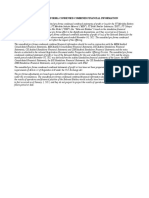0 ratings0% found this document useful (0 votes)
49 viewsFravashis
Fravashis
Uploaded by
adimarindocument eor
Copyright:
© All Rights Reserved
Available Formats
Download as PDF, TXT or read online from Scribd
Fravashis
Fravashis
Uploaded by
adimarin0 ratings0% found this document useful (0 votes)
49 views1 pagedocument eor
Original Title
fravashis
Copyright
© © All Rights Reserved
Available Formats
PDF, TXT or read online from Scribd
Share this document
Did you find this document useful?
Is this content inappropriate?
document eor
Copyright:
© All Rights Reserved
Available Formats
Download as PDF, TXT or read online from Scribd
Download as pdf or txt
0 ratings0% found this document useful (0 votes)
49 views1 pageFravashis
Fravashis
Uploaded by
adimarindocument eor
Copyright:
© All Rights Reserved
Available Formats
Download as PDF, TXT or read online from Scribd
Download as pdf or txt
You are on page 1of 1
3190 FRAVASHIS
Nyberg, H. S. Irans forntida religioner. Stockholm, 1937. Trans- BIBLIOGRAPHY
lated as Die Religionen des alten Iran (1938; 2d ed., Osna- Bailey, H. W. Zoroastrian Problems in the Ninth-Century Books
brück, 1966). (1943). Reprint, Oxford, 1971.
Widengren, Geo. “Leitende Ideen und Quellen der iranischen Duchesne-Guillemin, Jacques. “L’homme dans la religion iranien-
Apokalyptik.” In Apocalypticism in the Mediterranean World ne.” In Anthropologie religieuse, edited by C. Jouco Bleeker,
and the Near East, edited by David Hellholm, pp. 77–162. pp. 93–107. Leiden, 1955.
Tübingen, 1989.
Dumézil, Georges. “Vís: n: u et les Marút à travers la réforme zoroas-
Zaehner, R. C. The Dawn and Twilight of Zoroastrianism. Lon- trienne.” Journal asiatique 241 (1953): 1–25.
don, 1961.
Gnoli, Gherardo. “Le fravaši e l’immortalità.” In La mort, les morts
GHERARDO GNOLI (1987) dans les sociétés anciennes, edited by Gherardo Gnoli and
Translated from Italian by Roger DeGaris Jean-Pierre Vernant, pp. 339–347. Paris, 1982.
Hoffmann, Karl. “Das Avesta in der Persis.” In Prolegomena to the
Sources of the History of Pre-Islamic Central Asia, edited by
FRAVASHIS, beneficent and protective guardian spirits János Harmatta, pp. 89–93. Budapest, 1979.
whose services must be secured by means of ritual offerings, Kellens, Jean. “Les fravaši.” In Anges et démons, edited by Julien
are an essential element of the religious structure of Zoroas- Ries, pp. 99–114. Louvain-la-Neuve, 1989.
trianism. They play an important role in the frequency of
Lommel, Herman. Die Religion Zarathustras nach dem Awesta dar-
rainfall and are responsible for guaranteeing the prosperity gestellt. Tübingen, 1930.
and preservation of the family. As the spirits of the dead, they
Malandra, William W. “The ‘Fravaši Yašt.’” Ph.D. diss., Univer-
are the protagonists in a great feast held on the last night of
sity of Pennsylvania, 1971.
the year. They are thought to preexist human beings and to
survive them. Narten, Johanna. “Avestisch frauuasi-.” Indo-Iranian Journal 28
(1985): 35–48.
The fravashis do not appear in the Gāthās. In the Avesta,
Nyberg, H. S. Irans forntida religioner. Stockholm, 1937. Trans-
the first mention of them occurs in the Yasna Haptanhāiti,
lated as Die Religionen des alten Iran (1938; 2d ed., Osna-
and an entire hymn (Yashts 13) is dedicated to them. brück, 1966).
The conception of the fravashi has all the characteristics Schlerath, Bernfried. “Indo-Iranisch *var- ‘wählen.’” Studien zur
of an archaic, pre-Zoroastrian belief that was later absorbed Indologie und Iranistik (Festschrift Paul Thieme) 5–6 (1980):
and adapted by the tradition. Examples of these characteris- 199–208.
tics include their identification with the spirits of the dead Söderblom, Nathan. “Les Fravashis: Étude sur les traces dans le
(Söderblom, 1899, pp. 229–260, 373–418) and their war- mazdéisme d’une ancienne conception sur la survivance des
like nature. morts.” Revue de l’histoire des religions 39 (1899): 229–260,
As the spirits of the dead the fravashis have often been 373–418.
compared to the Roman manes or to the Indian pitarah: ; as GHERARDO GNOLI (1987)
warlike beings, they have been compared with the Germanic Translated from Italian by Roger DeGaris
valkyries or to the Indian Maruts, the company of celestial
warriors. In particular, in the context of the Indo-European
tripartite ideology, the fravashis are seen as a Zoroastrian sub-
stitute for the Maruts (Dumézil, 1953); both are linked to
FRAZER, JAMES G. (1854–1941), was a British an-
thropologist and historian of religion. James George Frazer,
the concepts and ethics of the Aryan Männerbund. Most like-
the eldest of four children, was born in preindustrial Glas-
ly, Zoroastrianism absorbed this ancient concept, typical of
gow, the son of a successful pharmacist. His parents were de-
a warrior society, through its ties to the cult of the dead and
vout members of the Free Church of Scotland, a conservative
reinterpreted the fravashis as combatants for the rule of
sect that in the 1840s had broken away from the (Estab-
Ahura Mazdā. We find such a zoroastrianization in the myth
lished) Church of Scotland on matters of church governance.
told in the third chapter of the Bundahishn (Book of primor-
Accordingly Frazer was raised in an atmosphere of deep
dial creation), which relates that the fravashis chose to be in-
piety, which, be it noted, he later said that he did not find
carnated in material bodies in order to fight Ahriman and
oppressive.
the evil powers instead of remaining peacefully in the celes-
tial world. Frazer early showed academic promise and entered the
The etymology of the word fravashi is uncertain. Origi- University of Glasgow at the then not unusually early age of
nally it may have been used to designate the spirit of a de- fifteen. There, he writes in a genial memoir composed at the
ceased hero who was endowed with *vr: ti, “valor” (Bailey, end of his life, three important things occurred: He con-
1943, pp. 107ff.); or it may have expressed the theological ceived his lifelong love of the classics, he came to see that the
concept, fundamental to Zoroastrianism, of choice, *fra-vr: ti world is governed by a system of unvarying natural laws, and
(Lommel, 1930, pp. 151, 159–163) or that of the profession he painlessly lost the religious faith of his childhood.
of faith (Hoffmann, 1979, p. 91; Schlerath, 1980, Frazer did brilliantly at Glasgow but soon realized that
pp. 207ff.). although Scottish education gave him a broader background
ENCYCLOPEDIA OF RELIGION, SECOND EDITION
You might also like
- The Subtle Art of Not Giving a F*ck: A Counterintuitive Approach to Living a Good LifeFrom EverandThe Subtle Art of Not Giving a F*ck: A Counterintuitive Approach to Living a Good LifeRating: 4 out of 5 stars4/5 (5935)
- The Gifts of Imperfection: Let Go of Who You Think You're Supposed to Be and Embrace Who You AreFrom EverandThe Gifts of Imperfection: Let Go of Who You Think You're Supposed to Be and Embrace Who You AreRating: 4 out of 5 stars4/5 (1106)
- Never Split the Difference: Negotiating As If Your Life Depended On ItFrom EverandNever Split the Difference: Negotiating As If Your Life Depended On ItRating: 4.5 out of 5 stars4.5/5 (879)
- Grit: The Power of Passion and PerseveranceFrom EverandGrit: The Power of Passion and PerseveranceRating: 4 out of 5 stars4/5 (598)
- Hidden Figures: The American Dream and the Untold Story of the Black Women Mathematicians Who Helped Win the Space RaceFrom EverandHidden Figures: The American Dream and the Untold Story of the Black Women Mathematicians Who Helped Win the Space RaceRating: 4 out of 5 stars4/5 (925)
- Shoe Dog: A Memoir by the Creator of NikeFrom EverandShoe Dog: A Memoir by the Creator of NikeRating: 4.5 out of 5 stars4.5/5 (545)
- The Hard Thing About Hard Things: Building a Business When There Are No Easy AnswersFrom EverandThe Hard Thing About Hard Things: Building a Business When There Are No Easy AnswersRating: 4.5 out of 5 stars4.5/5 (353)
- Elon Musk: Tesla, SpaceX, and the Quest for a Fantastic FutureFrom EverandElon Musk: Tesla, SpaceX, and the Quest for a Fantastic FutureRating: 4.5 out of 5 stars4.5/5 (476)
- Her Body and Other Parties: StoriesFrom EverandHer Body and Other Parties: StoriesRating: 4 out of 5 stars4/5 (831)
- The Emperor of All Maladies: A Biography of CancerFrom EverandThe Emperor of All Maladies: A Biography of CancerRating: 4.5 out of 5 stars4.5/5 (274)
- Brother RGG CEDocument3 pagesBrother RGG CEk.7330167No ratings yet
- The Little Book of Hygge: Danish Secrets to Happy LivingFrom EverandThe Little Book of Hygge: Danish Secrets to Happy LivingRating: 3.5 out of 5 stars3.5/5 (419)
- The World Is Flat 3.0: A Brief History of the Twenty-first CenturyFrom EverandThe World Is Flat 3.0: A Brief History of the Twenty-first CenturyRating: 3.5 out of 5 stars3.5/5 (2271)
- The Yellow House: A Memoir (2019 National Book Award Winner)From EverandThe Yellow House: A Memoir (2019 National Book Award Winner)Rating: 4 out of 5 stars4/5 (99)
- Devil in the Grove: Thurgood Marshall, the Groveland Boys, and the Dawn of a New AmericaFrom EverandDevil in the Grove: Thurgood Marshall, the Groveland Boys, and the Dawn of a New AmericaRating: 4.5 out of 5 stars4.5/5 (270)
- The Sympathizer: A Novel (Pulitzer Prize for Fiction)From EverandThe Sympathizer: A Novel (Pulitzer Prize for Fiction)Rating: 4.5 out of 5 stars4.5/5 (122)
- Team of Rivals: The Political Genius of Abraham LincolnFrom EverandTeam of Rivals: The Political Genius of Abraham LincolnRating: 4.5 out of 5 stars4.5/5 (235)
- A Heartbreaking Work Of Staggering Genius: A Memoir Based on a True StoryFrom EverandA Heartbreaking Work Of Staggering Genius: A Memoir Based on a True StoryRating: 3.5 out of 5 stars3.5/5 (232)
- On Fire: The (Burning) Case for a Green New DealFrom EverandOn Fire: The (Burning) Case for a Green New DealRating: 4 out of 5 stars4/5 (75)
- The Unwinding: An Inner History of the New AmericaFrom EverandThe Unwinding: An Inner History of the New AmericaRating: 4 out of 5 stars4/5 (45)
- Doctor DataDocument9 pagesDoctor DataKetki Naik100% (1)
- LONGKIMKHORN Resume 20121218Document18 pagesLONGKIMKHORN Resume 20121218Kimkhorn LongNo ratings yet
- VrtraDocument2 pagesVrtraadimarinNo ratings yet
- Indo European ReligionDocument16 pagesIndo European Religionadimarin100% (1)
- Human SacrificeDocument10 pagesHuman SacrificeadimarinNo ratings yet
- IncantationDocument5 pagesIncantationadimarinNo ratings yet
- Chinghis KhanDocument2 pagesChinghis KhanadimarinNo ratings yet
- FreyjaDocument3 pagesFreyjaadimarinNo ratings yet
- CursingDocument12 pagesCursingadimarinNo ratings yet
- AhimsaDocument1 pageAhimsaadimarinNo ratings yet
- Balarama Si BaldrDocument2 pagesBalarama Si BaldradimarinNo ratings yet
- Culture HeroesDocument3 pagesCulture HeroesadimarinNo ratings yet
- ArhatDocument2 pagesArhatadimarinNo ratings yet
- Special Edition Sword Stick SocietyDocument72 pagesSpecial Edition Sword Stick Societyadimarin100% (2)
- Bodily MarksDocument6 pagesBodily MarksadimarinNo ratings yet
- Black BeltDocument68 pagesBlack Beltadimarin100% (2)
- Top: "The Fight With The Pirates," Strobridge Litho Co. 1907 (Private Collector) - Bottom: This Is TheDocument1 pageTop: "The Fight With The Pirates," Strobridge Litho Co. 1907 (Private Collector) - Bottom: This Is TheadimarinNo ratings yet
- Stw45Nm60: N-Channel 650V@Tjmax - 0.09 - 45A - To-247 Mdmesh™ Power MosfetDocument12 pagesStw45Nm60: N-Channel 650V@Tjmax - 0.09 - 45A - To-247 Mdmesh™ Power MosfetYani RiyaniNo ratings yet
- No.39 E 96Document2 pagesNo.39 E 96Fatu KromahNo ratings yet
- The King and IDocument2 pagesThe King and ICarl Denver BaccayNo ratings yet
- Assignment in SociologyDocument2 pagesAssignment in SociologyElissa PagulayanNo ratings yet
- Fixed Income Markets and Products: 5 - Bond Investment StrategiesDocument13 pagesFixed Income Markets and Products: 5 - Bond Investment StrategiesUday ChaudhariNo ratings yet
- MichelangeloDocument11 pagesMichelangeloFlorinAnghelNo ratings yet
- Pop-Culture Diplomacy in Japan: Soft Power, Nation Branding and The Question of International Cultural Exchange'Document6 pagesPop-Culture Diplomacy in Japan: Soft Power, Nation Branding and The Question of International Cultural Exchange'sioyaki170No ratings yet
- Directorate Office Directorate of Education (Govt. of NCT of Delhi) Appointment OrderDocument1 pageDirectorate Office Directorate of Education (Govt. of NCT of Delhi) Appointment OrderManish TomarNo ratings yet
- Lesson 4 The Birth of JesusDocument17 pagesLesson 4 The Birth of JesusNimrod LadianaNo ratings yet
- Wrongful Restraint and Wrongful ConfinementDocument8 pagesWrongful Restraint and Wrongful ConfinementPb 29 Speaker 1No ratings yet
- Informasi Keuangan Pro Forma Tidak Diaudit 31 Desember 2021 Dan 30 November 2022Document8 pagesInformasi Keuangan Pro Forma Tidak Diaudit 31 Desember 2021 Dan 30 November 2022KhresnaNo ratings yet
- Ducati Monster 696 - Eu - 2009Document142 pagesDucati Monster 696 - Eu - 2009uauxjoNo ratings yet
- May 2020Document4 pagesMay 2020camachoyadira72No ratings yet
- Mitchell v. LathDocument2 pagesMitchell v. Lathcrlstinaaa100% (2)
- Mexico: Preparing My Dream TripDocument15 pagesMexico: Preparing My Dream TripYareli Román CarNo ratings yet
- Research Methodsfor Archi.Document15 pagesResearch Methodsfor Archi.Denvergerard TamondongNo ratings yet
- Securitisation and Reconstruction of Financial Assets and Enforcement of Security Interest Act, 2002 (Sarfaesi Act)Document18 pagesSecuritisation and Reconstruction of Financial Assets and Enforcement of Security Interest Act, 2002 (Sarfaesi Act)varun100% (1)
- Derby Arrest WarrantDocument15 pagesDerby Arrest WarrantThe Valley IndyNo ratings yet
- Trafalgar Place - CEMPDocument38 pagesTrafalgar Place - CEMPBermondsey Bill OwenNo ratings yet
- Respond To Emergencies: Hipboard Contingency PlanDocument3 pagesRespond To Emergencies: Hipboard Contingency Planmithilesh seloteNo ratings yet
- Product-Selling Strategies That Add Value: Quicktime™ and A Decompressor Are Needed To See This PictureDocument31 pagesProduct-Selling Strategies That Add Value: Quicktime™ and A Decompressor Are Needed To See This PictureErikaa RahmaNo ratings yet
- Schema TherapyDocument167 pagesSchema TherapyGloria KentNo ratings yet
- Oratorical SpeechDocument2 pagesOratorical SpeechHanna Maureen MaglangitNo ratings yet
- Jane Austen Art of CharacterizationDocument4 pagesJane Austen Art of CharacterizationSara SyedNo ratings yet
- Inf NOC UMDocument32 pagesInf NOC UMchristinedala7No ratings yet
- Home Visit Risk Assessment FormDocument4 pagesHome Visit Risk Assessment FormNenad KrsnikNo ratings yet
- Cyrus Pallonji MistryDocument3 pagesCyrus Pallonji MistryApoorv Vinay KandharkarNo ratings yet





















































































